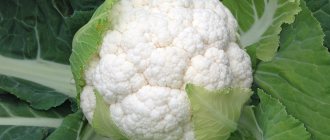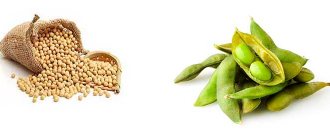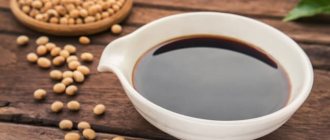Disputes about the benefits and harms of products derived from soybeans have been going on for a long time, and scientists have not yet come to a consensus on this matter. One such product that has received a lot of attention is soy milk. Of course, it has nothing in common with milk of animal origin (cow, goat, etc.), but it is still called milk because it has a similar liquid consistency, white color, a rather pleasant sweetish taste and a slight specific smell. Soy milk, like cow's milk, can turn sour, then it turns into delicious soy kefir, cheese or cottage cheese (tofu).
This plant-based product is becoming more and more popular every day in the world, especially in the countries of East Asia (China, South Korea, Japan), which is considered the birthplace of milk from plant products, as well as in the countries of South America, the USA, Canada and Western Europe. In addition, soy products, including milk, have become an integral part of the diet of vegetarians and people on fasting and various diets.
What it is
Soy milk is a white liquid with a slight bean aroma and a sweetish taste. It is made from specially soaked soybeans, pureed, filtered and brought to a boiling point.
Soy milk was first produced in China, and today it is more popular and in demand in Asia and North America. Here it is an inexpensive alternative to cow's milk.
Important! The color and taste of milk is really similar to cow's milk, but it does not contain milk sugar, and this is important for anyone who is lactose intolerant.
Every year, soybean plantations increase by thousands of hectares; they are used to make meat substitutes, tofu cheese and milk.
Recommended reading: Health Benefits of Tofu Cheese
Chemical composition of soy milk
All legumes are valued for the presence of proteins similar in structure to animals. And soybeans are in first place in this. Its amino acids are closest to those of animals, which is why soy meat, milk and cheese are most often consumed by vegetarians.
Composition of healthy soy milk:
- vitamins B1, B2, B6, E, A;
- potassium, sodium, phosphorus;
- isoflavones;
- phytoestrogens;
- cellulose;
- lecithin.
Beans contain a lot of phytic acid and are completely free of cholesterol.
Calorie content of soy milk. Chemical composition and nutritional value.
Nutritional value and chemical composition of soy milk.
The table shows the nutritional content (calories, proteins, fats, carbohydrates, vitamins and minerals) per 100 grams of edible portion.
| Nutrient | Quantity | Norm** | % of the norm in 100 g | % of the norm in 100 kcal | 100% normal |
| Calorie content | 60 kcal | 1684 kcal | 3.6% | 6% | 2807 g |
| Squirrels | 3 g | 76 g | 3.9% | 6.5% | 2533 g |
| Fats | 2.4 g | 56 g | 4.3% | 7.2% | 2333 g |
| Carbohydrates | 6 g | 219 g | 2.7% | 4.5% | 3650 g |
| Alimentary fiber | 0.4 g | 20 g | 2% | 3.3% | 5000 g |
| Water | 85.61 g | 2273 g | 3.8% | 6.3% | 2655 g |
| Ash | 0.65 g | ~ | |||
| Vitamins | |||||
| Vitamin A, RE | 70 mcg | 900 mcg | 7.8% | 13% | 1286 g |
| Retinol | 0.07 mg | ~ | |||
| beta carotene | 0.002 mg | 5 mg | 250000 g | ||
| Vitamin B1, thiamine | 0.022 mg | 1.5 mg | 1.5% | 2.5% | 6818 g |
| Vitamin B2, riboflavin | 0.262 mg | 1.8 mg | 14.6% | 24.3% | 687 g |
| Vitamin B4, choline | 23.6 mg | 500 mg | 4.7% | 7.8% | 2119 g |
| Vitamin B5, pantothenic | 0.089 mg | 5 mg | 1.8% | 3% | 5618 g |
| Vitamin B6, pyridoxine | 0.077 mg | 2 mg | 3.9% | 6.5% | 2597 g |
| Vitamin B9, folates | 11 mcg | 400 mcg | 2.8% | 4.7% | 3636 g |
| Vitamin B12, cobalamin | 0.7 mcg | 3 mcg | 23.3% | 38.8% | 429 g |
| Vitamin C, ascorbic acid | 1.7 mg | 90 mg | 1.9% | 3.2% | 5294 g |
| Vitamin D, calciferol | 1 mcg | 10 mcg | 10% | 16.7% | 1000 g |
| Vitamin D2, ergocalciferol | 1 mcg | ~ | |||
| Vitamin E, alpha tocopherol, TE | 0.11 mg | 15 mg | 0.7% | 1.2% | 13636 g |
| Vitamin K, phylloquinone | 3 mcg | 120 mcg | 2.5% | 4.2% | 4000 g |
| Vitamin RR, NE | 0.513 mg | 20 mg | 2.6% | 4.3% | 3899 g |
| Macronutrients | |||||
| Potassium, K | 143 mg | 2500 mg | 5.7% | 9.5% | 1748 g |
| Calcium, Ca | 120 mg | 1000 mg | 12% | 20% | 833 g |
| Magnesium, Mg | 15 mg | 400 mg | 3.8% | 6.3% | 2667 g |
| Sodium, Na | 53 mg | 1300 mg | 4.1% | 6.8% | 2453 g |
| Phosphorus, P | 51 mg | 800 mg | 6.4% | 10.7% | 1569 g |
| Microelements | |||||
| Iron, Fe | 0.48 mg | 18 mg | 2.7% | 4.5% | 3750 g |
| Copper, Cu | 206 mcg | 1000 mcg | 20.6% | 34.3% | 485 g |
| Selenium, Se | 4.8 mcg | 55 mcg | 8.7% | 14.5% | 1146 g |
| Zinc, Zn | 0.34 mg | 12 mg | 2.8% | 4.7% | 3529 g |
| Digestible carbohydrates | |||||
| Mono- and disaccharides (sugars) | 7.86 g | max 100 g | |||
| Essential amino acids | |||||
| Arginine* | 0.131 g | ~ | |||
| Valin | 0.081 g | ~ | |||
| Histidine* | 0.043 g | ~ | |||
| Isoleucine | 0.08 g | ~ | |||
| Leucine | 0.13 g | ~ | |||
| Lysine | 0.092 g | ~ | |||
| Methionine | 0.019 g | ~ | |||
| Threonine | 0.075 g | ~ | |||
| Tryptophan | 0.027 g | ~ | |||
| Phenylalanine | 0.079 g | ~ | |||
| Nonessential amino acids | |||||
| Alanin | 0.073 g | ~ | |||
| Aspartic acid | 0.201 g | ~ | |||
| Glycine | 0.072 g | ~ | |||
| Glutamic acid | 0.34 g | ~ | |||
| Proline | 0.103 g | ~ | |||
| Serin | 0.098 g | ~ | |||
| Tyrosine | 0.062 g | ~ | |||
| Saturated fatty acids | |||||
| Saturated fatty acids | 0.24 g | max 18.7 g | |||
| 16:0 Palmitinaya | 0.15 g | ~ | |||
| 18:0 Stearic | 0.05 g | ~ | |||
| Monounsaturated fatty acids | 0.379 g | min 16.8 g | 2.3% | 3.8% | |
| 18:1 Oleic (omega-9) | 0.31 g | ~ | |||
| 20:1 Gadoleic (omega-9) | 0.01 g | ~ | |||
| Polyunsaturated fatty acids | 0.836 g | from 11.2 to 20.6 g | 7.5% | 12.5% | |
| 18:2 Linolevaya | 0.584 g | ~ | |||
| 18:3 Linolenic | 0.075 g | ~ | |||
| Omega-3 fatty acids | 0.075 g | from 0.9 to 3.7 g | 8.3% | 13.8% | |
| Omega-6 fatty acids | 0.584 g | from 4.7 to 16.8 g | 12.4% | 20.7% | |
| Other substances | |||||
| Caffeine | 2 mg | ~ | |||
| Theobromine | 23 mg | ~ |
The energy value of soy milk is 60 kcal.
Primary Source: Created in the application by the user. Read more.
** This table shows the average levels of vitamins and minerals for an adult. If you want to know the norms taking into account your gender, age and other factors, then use the “My Healthy Diet” application.
Beneficial properties of soy milk
Plant origin, the presence of important amino acids, vitamins and minerals make soy milk a truly healthy product. It is included in the diet of vegetarians, people with hypersecretion of gastric juice, and hypertensive patients.
Beneficial properties of soy milk:
- cleanses the intestines of toxins, improves peristalsis;
- strengthens the heart and blood vessels;
- protects female reproductive organs from cancer;
- hypoallergenic;
- antioxidant;
- improves the functioning of the nervous system.
The high protein content makes milk a valuable product for the construction of new tissues and systems. The absence of cholesterol does not burden blood vessels, which is important for hypertensive patients. The presence of potassium is also important for the normal functioning of the cardiovascular system.
It is useful to include milk in the diet of patients with stomach ulcers, chronic cholecystitis, atherosclerosis, coronary heart disease, and obesity.
For women
Isoflavones, phytoestrogens and vitamin E are substances present in soy milk that have a direct effect on the female body. Vitamin E is a strong antioxidant that protects the body from harmful free radicals. In addition, it is beneficial for hair, skin and nails.
Phytoestrogens are analogs of female sex hormones. Doctors have different opinions about them. For hormonal imbalances in women, especially during menopause, soy will be beneficial. Her phytoestrogens will compensate for the lack of her own estrogens, which means that the woman will suffer less from hot flashes, fever and ailments.
Isoflavones, according to many scientists, can protect women from ovarian, cervical and breast cancer. The hypothesis has not yet been fully confirmed, but research in this area is being actively carried out.
For men
Men should not consume soy in large quantities. This is due to phytoestrogens, which can cause disruptions in the synthesis of male hormones. This is fraught with the development of prostate pathologies and impaired spermatogenesis. If a man has problems with the thyroid gland, it is better not to consume soy.
Soy milk - health benefits and harms
It is believed that soy milk was invented by the Chinese philosopher and part-time alchemist Liu An, who lived in the second century AD. He lived well, but the trouble was, he had a grumpy mother. This venerable old lady no longer had any teeth, so she pushed Liu to invent a way to consume her favorite soybeans without “bothering” with chewing them. In addition, she had one more modest desire - to live forever, and since her son was listed as an alchemist, he was tasked with inventing nothing less than an elixir of immortality. The unfortunate Liu did not invent an elixir, but he discovered a method for preparing soy milk, and subsequently subjected it to coagulation and obtained the famous tofu cheese, which incredibly pleased his mother, who from now on feasted on her favorite product, which had acquired softness and tenderness. The nutritional value of soy milk is approximately on the same level as cow's milk, and the same can be said in relation to the amount of carbohydrates. But there is more protein in the plant product - almost six percent per hundred milliliters, versus two percent per hundred milliliters of cow's milk. And although this protein is plant-based, it is easier to digest and is considered the best alternative to animal protein. What other interesting things can you tell about the health benefits of soy milk, and what are its harms? Let's try to find out.
Benefits of soy milk
The health benefits of soy milk are primarily due to its high content of monounsaturated and polyunsaturated fatty acids, including Omega-3 and Omega-6. Since all components of soy milk are of plant origin, they do not saturate the body with “bad” cholesterol. Consuming soy milk has also been shown to reduce levels of triglycerides (i.e. fatty acids), harmful to our body, the consumption of which increases the risk of heart attack. These properties improve the lipid profile, due to which milk has a preventive effect on diseases of the circulatory system. Other valuable nutrients found in soy milk include B vitamins, potassium, iron and magnesium. Soy milk also contains plant fibers that are beneficial for digestive processes.

Researchers from the University of Illinois have shown that soy consumption significantly reduces the incidence of prostate cancer. Substances contained in soy milk, especially genisteins, protect the prostate gland from cancerous changes. Also noteworthy is an additional finding from the study—equivalent consumption of soy and tomatoes showed the greatest impact on reducing cancer incidence. The benefits of soy milk for women are especially obvious. Consumption of soy helps relieve menopausal symptoms (including hyperactivity, excessive nervousness and hot flashes). Soy products are rich in phytoestrogens - substances of plant origin similar to female hormones (estrogens). They demonstrate preventive activity in women with breast, ovarian or cervical cancer. On the other hand, in fairness, we note that there are many assumptions about the negative effects of phytoestrogens. Hormonal imbalances occur in boys and men because consumption of soy products reduces testosterone production. But such products are strongly recommended by nutritionists for weight loss. The high protein content makes the product nutritious; even a small portion of milk leads to satiety and a long feeling of fullness. An additional advantage of soy milk in the fight against extra pounds is the presence of monounsaturated fatty acids in it, which reduce the absorption of fat in the body, and therefore do not contribute to the increase of body fat.
The compounds contained in soy milk improve elasticity and promote greater permeability of blood vessels, increasing their resistance to fluctuations in blood pressure. Omega 3 and 6 fatty acids and antioxidants protect blood vessels from blockage and damage. The already mentioned phytoestrogens have a positive effect on the skeletal system, especially weakened due to age-related changes. If you suffer from osteoporosis, regularly drink soy milk, fortified with calcium and vitamin D. It has fewer calories than cow's milk and is recommended for people struggling with digestive diseases because it does not curdle in the stomach and does not increase the amount of stomach acid that causes ulceration. stomach and duodenum. The product is indicated for people suffering from diabetes, as well as those who are struggling with extra pounds.
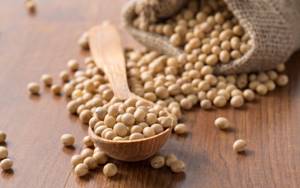
Contraindications
Basically, the consumption of soy milk is due to the inability of some people's bodies to digest cow's milk. In addition, there may be allergies to various components of animal milk. However, do not forget that soy milk can also lead to an allergic reaction. Before you start using it, you should consult your doctor (especially for young children). If you don’t want to consult a doctor, then start drinking soy milk with small portions and carefully monitor your body’s reaction. Additionally, it should be mentioned that legumes, including soybeans, are difficult to digest foods. Their use should be limited in people with stomach problems or irritable bowel syndrome. Despite the predominant advantages of soy milk over cow's milk, note that the plant product is characterized by a lower content of vitamin D and calcium.
Soy milk has a number of health benefits, but consuming it may have adverse health effects. First of all, it is not supported by opponents of GMO foods (genetically modified organisms). True, most of the research conducted to date regarding GMOs has shown that they pose no more of a threat than non-modified organisms. But Greenpeace insists with enviable persistence that GMOs are harmful to the environment, including people. With new reports constantly appearing, the issue of genetic crops is the subject of much discussion. Don’t consider yourself a special person who only eats healthy and natural foods. Do not believe the labels on the packages, you are simply misled. Just remember that genetically modified soy definitely dominates the range of foods available on the market today. At the moment, its global production, according to various estimates, is more than seventy percent and continues to grow. It is becoming increasingly difficult to obtain unmodified soybeans from organic agriculture.
What else can you tell us about the health risks of soy milk? Soy products are high in phytic acid, which reduces the absorption of valuable nutrients including calcium, iron, zinc and magnesium. Consumption of soy products, including soy milk, should be minimized in people suffering from hypothyroidism due to the inhibition of iodine absorption by counteracting nutrients known as hotigens present in soy products. Consumption of soy products in excess can contribute to the formation of thyroid goiter. Too much soy can cause allergies, so it is recommended to consume no more than fifty grams of the product per day. Please note that cooking soy reduces the content of harmful substances by thirty percent. Despite the many positive properties of the above-mentioned phytoestrogens (isoflavones and lignans), there is an opinion that excessive love of soy products in men can not only reduce the amount of testosterone, but even negatively affect fertility, reducing sperm motility and even destroying their DNA. Eating too much soy can also lead to erectile dysfunction.
As you may have noticed, soy milk is one of the products that has its supporters and opponents. But considering that its advantages are much greater, and its disadvantages are only “supposed” and not proven by 100% of consumption, it should definitely be included in the daily menu. Consuming soy milk in moderation will not cause harm, but will only enrich our diet with valuable nutrients. Taking into account calorie content and health status, the choice of soy products in the diet should be individual.
Soy milk during pregnancy and breastfeeding
There are no categorical prohibitions on soy for pregnant and lactating women. But there is a group of factors in the presence of which it is better to refuse the product. Thus, it is undesirable to drink soy milk if you have hypotension and a tendency to low blood pressure. If you are allergic to other legume products.
Advice! You should not drink milk in large quantities or eat soy products if the level of calcium in the body is low.
When breastfeeding, soy milk will be useful if the child is allergic to cow's milk protein. A woman can replace dairy products with soy, but also in small quantities, so as not to cause allergies and colic in the baby.
What are the benefits of soy milk?
I would like to immediately note that numerous studies of the composition and effect of soy milk on humans and animals have led to an unequivocal answer - there is more benefit than harm. Therefore, we will understand and give advice on the use of this product. After all, milk is valuable because it is low-calorie, unlike cow's milk, contains a lot of protein, and therefore is suitable for various diets.
What is soy milk? Product benefits.
If you are not yet familiar with the product, know that it got its name due to its composition, which is similar to an animal product. But milk does not literally mean that it is milk. It’s simply a drink expressed from the cake of a processed product - soy, almonds, rice. As you can see, milk (substitute) can be different. In this case, we are talking about a drink made from soybean cake.
The product comes from East Asia, where its first production began. To do this, soaked beans are used, and then the whole mass is boiled and pureed, followed by cooling. Next, the mass is filtered and heated to a certain temperature. This is how we get a final product that is very tasty and healthy.
Soy milk research and results
The public is currently divided on the health benefits and harms of soy products. Definitely, if you use an environmentally friendly product, there is no need to worry about your health. But how can you determine that you are buying environmentally friendly raw materials (soy) or soy drink? Read the packaging carefully, in small print on the back - where it was delivered from, where the milk was produced and whether there are GMOs in the product.
You should know that the protein contained in soybeans becomes denatured when cooked for a long time and with strong heating and there will be no benefit from such a product , therefore, being confident in the manufacturer, you can choose a healthy product. Or prepare milk at home, we will give the recipe below.
Scientists have discovered that phytic acid in milk slows down the absorption of iron, calcium, and magnesium from other products. This is of course a proven fact, but in this case, you should avoid consuming soy milk and sesame at the same time , for example, if you want to get the benefits of both products.
Is soy milk okay for children?
This product can be given to children from 5 years of age. It is useful because it is a source of protein, which is necessary for a growing child’s body to form cells and tissues. However, there are still infant formulas based on soy milk that serve as an alternative to lactose-free milk formulas. Soy milk for a child is indicated for intolerance to milk sugar and protein.
It is dangerous for teenage girls to drink milk made from legumes; the product can disrupt the balance of hormones and cause early menstruation. Undesirable for hypothyroidism and other problems with the thyroid gland. For boys, this product is less dangerous.
Benefits of soy milk for weight loss
Soy milk is a healthy popular product for weight loss. It comes in different fat contents and is enriched with beneficial elements, most often calcium. In dietary nutrition, food is valued for its low calorie content and high protein content. The fiber in the product helps cleanse the intestines of toxins and eliminate the feeling of hunger for a long time.
Important! The absence of animal fat suggests that milk does not contribute to weight gain, but, on the contrary, improves the process of weight loss.
There are specially designed soy diets. They are based on the consumption of soy milk and tofu cheese. They either drink milk or prepare porridge using it. It is useful to drink coffee with soy milk during a diet. The essence of the diet is a high proportion of protein consumed, which takes a long time to be digested by the body, requires energy expenditure and is not stored in fatty tissues.
About soy milk
Let's talk about what soy milk is and what beneficial properties it has. How it differs from the usual, useful or harmful, let’s find out some interesting facts. Let's talk about how it is made. Discussions on the topic “the benefits and harms of soy milk” have been going on for many years, and new arguments are being put forward in favor of one point of view or another. It has been established that it is not suitable for everyone and not always. It is important when creating various diets, especially if the goal is to achieve weight loss. The calorie content of the product is low. Its benefits for weight loss have been confirmed by numerous studies by Russian and foreign scientists, as well as by people who have personally used it for these purposes.
Note! The drink also has disadvantages: the absence of many microelements, which is why manufacturers add calcium.
Drinking from soybeans was invented by the Chinese Liu An, who lived two hundred years after the birth of Christ. His old mother loved beans, but was unable to eat them due to dental disease. Then the cunning thinker brewed a drink from ground soybeans, and the result was something like a suspension. Mom really liked it, and its benefits were obvious. Gradually, the product spread throughout China, but it came to Europe only in 1939, when entrepreneur Harry Miller brought a new soy drink. The Europeans tried the drink and liked it. The cream of society fell in love with drinking coffee with soy milk. Its benefits and harms were not discussed then. People sometimes ask if soy milk can be boiled. It is quite possible to cook porridge on it. They can be cooked as in the traditional way.
How is soy milk made?
It is made like this.
- Soybeans are ground into fine flour.
- Ground soybeans are mixed with water in proportions of one to four, eight or sixteen.
- Everything mixes well.
- A sediment is released, which is dried, pressed and used to feed livestock. This sediment has beneficial properties. There is a lot of protein, animals like its taste.
- Filter the mixture, freeing it from the smallest particles.
- Boiling is carried out at 150 degrees.
- They are poured into special containers that provide the necessary shelf life and transportation.
Vitamins and microelements are usually added to the finished product, including if it is intended for children. Thus, it is a natural product. Those who like to cook themselves can be advised to prepare it at home.
Calorie content and composition of soy milk
Let's discuss the composition of the drink. By making a query in a search engine on the topic “calorie content of soy milk,” you can get various information. The calorie content of soy milk ranges from forty-five to sixty kcal per 100 g of liquid. Where does the difference come from? Different manufacturers add various substances to the drink to increase the competitiveness of their product. When calculating calorie content, you must adhere to the numbers indicated on the bottle label. On average, per 100 g it contains the following amount of substances in grams:
- protein content 2.95;
- fat 2.00;
- carbohydrates 3.06;
- dietary fiber 0.5;
- ash substances 0.65;
- water 85.7.
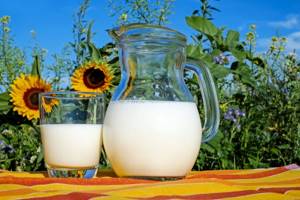
The low percentage of fat allows us to recommend the drink for weight loss. Soybean dishes generally have low calorie content, but are rich in vitamins. Vitamin and mineral composition:
- Tocopherol acetate. Fights the aging process.
- Ascorbic acid. Improves blood composition, enhances immunity.
- Thiamine. Fights diseases of the nervous system.
- Riboflavin. Helps metabolism.
- Choline. It also strengthens the nerves and normalizes the amount of sugar in the blood.
- Pantothenic acid. Helps in wound healing.
- Pyridoxine. Improves blood composition.
- Folic acid. Improves emotional background.
- A nicotinic acid. Reduces blood cholesterol levels.
- Cholecalceferol. Helps improve blood composition.
- Potassium. Its benefit is that it participates in all metabolic processes.
- Calcium. Helps regulate the activity of the cardiovascular system.
- Magnesium. Helps with nervous tension.
- Phosphorus. Helps maintain bone and hair structure.
- Sodium. Needed for metabolic processes.
- Zinc. Strengthens the immune system.
- Copper. It has anti-inflammatory properties and also improves immunity.
The drink is a real storehouse of nutrients. Soy milk is harmful: is it harmful? We will find out more about this below.
How is soy milk different from regular milk?
People got milk by taming a wild goat. This happened approximately 60,000 years ago. Then it was the cow's turn. Drinking from soy also has a long history. In appearance, all types are very similar, what are the differences between soy drink and cow drink.
- It is obtained by processing plant materials, not animals.
- Does not contain lactose.
- The calorie content is significantly lower since there is no fat.
- The color is a little darker, reminiscent of melted butter.
- No cholesterol.
- Has a pleasant smell.
- The taste is sweeter.
The consistency is similar to diluted cow's milk. It's nice to drink soy milk with vanilla.
Which milk is better: soy or cow's milk?
The benefits and harms of cow and soy milk have been discussed many times; dissertations have even been written on this topic.
Interesting fact. Experts have not yet come to a consensus which is better.
Here are the main points.
- Cow's milk is rich in calcium, while vegetable milk has almost none. This forces manufacturers to further enrich the product with this mineral.
- Vegetables contain a lot of protein.
- It is fat-free and does not increase blood cholesterol levels.
- Rich in B vitamins. One cup contains up to forty-five percent of a person’s daily requirement.
Cow's is more nutritious. Plant-based is recommended for those whose bodies cannot tolerate animal products. Can I drink soy milk instead of cow's milk? Yes.
The use of soy milk in cosmetology
Soy milk is especially beneficial for the skin - it nourishes, tones, rejuvenates, and protects against harmful environmental influences. There are a lot of cosmetic brands that produce soy-based care and medicinal cosmetics.
At home, you can make natural healthy masks and creams using soy. Pure milk is used to wash and wipe the face for nutrition and cleansing. To prepare a mask, the product is mixed with vegetable or fruit purees and applied to the skin of the face and neck. For dry and sensitive skin, add vegetable or cosmetic oil to the mask. In the morning and evening, to revitalize the skin and smooth out wrinkles, it is useful to wipe the skin with ice cubes made from soy milk.
Benefits of soy milk powder
If the benefits of natural soy milk are still in question, then you should not expect a good effect on the body from the dry product. If you carefully study the composition of the dry product on any of the store packs, you will see that it contains a lot of strange additives, from corn syrup and stabilizer to emulsifier and salt. Everything is pure chemistry.
Powdered milk was created to cover the lack of natural milk, but it is used mainly in Asian countries. The benefits of the product are minimal, but the harm can be significant.
Soy milk. Benefits for women, reviews about it
Composition of soy milk
Soy is a product that is poisonous in its raw form , but is used everywhere when processed. The largest producers so far are the States.

Soy products
In Japan and Thailand, in every supermarket you can buy soy milk in any flavor - chocolate, vanilla, strawberry, simply because they consider it both tasty and healthy. By the way, the Japanese and Thais look youthful and feel energetic every day, unlike Europeans.
Milk contains a lot of protein - 30% of the total content of the drink, microelements - calcium, phosphorus, potassium, magnesium, selenium, zinc. And of course, it is easily absorbed by the body due to the content of amino acids, lecithin, fiber and glucose. Vitamin E is a wonderful addition to this milk - an antioxidant and a famous vitamin for female beauty.
Powdered soy milk, the benefits and harms of which also depend on the environmental friendliness of the product, is sold on store shelves next to products for diabetics and allergy sufferers. This is also a substitute for cow's milk, like ready-made milk in a tetra pack. Reviews about this milk are mostly positive.
The composition contains little calcium, so manufacturers try to enrich the product that goes on sale with calcium and vitamin B12. 100 grams of soy milk contains 33 calories, which equates to 140 kJ of energy.
Composition of the product:
- Proteins – 2.85 grams
- Fat – 1.60 grams
- Carbohydrates – 1.75 grams
contains absolutely Therefore, it is applicable in dietary nutrition. Whether you're allergic, diabetic, or just trying to stay fit, soy milk is good for you. This is a beauty vitamin for your skin; its use helps cleanse and renew epidermal cells, as well as improve the condition of hair (zinc, selenium, vitamin E).

Soybean pods, dry beans, soy milk, tofu, sauce
And most importantly, soy milk, the benefits of which have been proven specifically for women, contains phytoestrogens (isoflavones, genistein and others) . Therefore, drinking milk has a beneficial effect on reproductive function, reduces the occurrence of breast cancer, and improves condition during menopause.
That is, by consuming milk, you increase the supply of your own estrogens. Here are the benefits of soy milk for women. A glass of milk is equivalent to the use of hormonal drugs that improve the balance of hormones. Why take medicine if there is a natural product?!
Consuming soy drink can be both beneficial and harmful in some cases. Since milk contains a lot of protein, it is useful when playing sports, for women who take care of themselves, it is the prevention of osteoporosis and strengthening bones and muscles. The benefits of soy milk for pregnant women have not been proven, but they have not been refuted either.
How to make soy milk at home
The process of making healthy milk is very simple. First, washed and selected beans are soaked for 12 hours in cool water to swell. Then, together with water, they are pureed in a blender and squeezed. The resulting liquid is boiled over low heat for 15 minutes with salt, sugar and cinnamon as desired. Next, the resulting milk is cooled and stored in the refrigerator.
Ingredient proportions:
- 200 g soybeans;
- 900 ml water;
- 2 tsp. Sahara;
- a pinch of salt and cinnamon.
From such a portion of the original ingredients, about 1 liter of healthy milk is obtained.
How to store soy milk
The raw drink can be stored in the refrigerator for three days, otherwise the product will cause harm to the body. If you purchase milk in original packaging, then you need to look at the instructions. Manufacturers add preservatives to milk, which allow it to be stored for up to six months. It is best to store milk in the refrigerator at a temperature of three to four degrees Celsius. Powdered soy milk can be stored for years and is the most economical way. Consumption of powdered milk is simple: just dilute it with water.
Harm of soy milk and contraindications
Despite some beneficial properties, soy milk can be harmful to health. First of all, it is dangerous due to the content of phytic acid, which partially blocks the absorption of calcium, zinc, iron and other elements. With frequent use, this can lead to the development of a deficiency of these minerals.
It is contraindicated for:
- disturbances in the functioning of the endocrine system;
- in adolescence;
- the risk of developing uterine cancer in women;
- hypotension and asthenia.
In other cases, when using the product you need to know when to stop.


